Forums
- Forums
- Duggy's Reference Hangar
- RAF Library
- Hawker Sea Fury
Hawker Sea Fury
Post a reply
- Go to Previous topic
- Go to Next topic
- Go to Welcome
- Go to Introduce Yourself
- Go to General Discussion
- Go to Screenshots, Images and Videos
- Go to Off topic
- Go to Works in Progress
- Go to Skinning Tips / Tutorials
- Go to Skin Requests
- Go to IJAAF Library
- Go to Luftwaffe Library
- Go to RAF Library
- Go to USAAF / USN Library
- Go to Misc Library
- Go to The Ops Room
- Go to Made in Germany
- Go to Campaigns and Missions
- Go to Works in Progress
- Go to Juri's Air-Raid Shelter
- Go to Campaigns and Missions
- Go to Works in Progress
- Go to Skinpacks
- Go to External Projects Discussion
- Go to Books & Resources
-
4 years agoSat Jul 29 2023, 08:47amDuggy
 Main AdminThe Hawker Sea Fury is a British fighter aircraft designed and manufactured by Hawker Aircraft. It was the last propeller-driven fighter to serve with the Royal Navy, and one of the fastest production single reciprocating engine aircraft ever built. Developed during the Second World War, the Sea Fury entered service two years after the war ended. It proved to be a popular aircraft with a number of overseas militaries, and was used during the Korean War in the early 1950s, as well as against the 1961 Bay of Pigs Invasion of Cuba.
Main AdminThe Hawker Sea Fury is a British fighter aircraft designed and manufactured by Hawker Aircraft. It was the last propeller-driven fighter to serve with the Royal Navy, and one of the fastest production single reciprocating engine aircraft ever built. Developed during the Second World War, the Sea Fury entered service two years after the war ended. It proved to be a popular aircraft with a number of overseas militaries, and was used during the Korean War in the early 1950s, as well as against the 1961 Bay of Pigs Invasion of Cuba.
The Sea Fury's development was formally initiated in 1943 in response to a wartime requirement of the Royal Air Force (RAF), with the aircraft initially named Fury. As the Second World War drew to a close, the RAF cancelled their order for the aircraft; however, the Royal Navy saw the type as a suitable carrier aircraft to replace a range of increasingly obsolete or poorly-suited aircraft being operated by the Fleet Air Arm. Development of the Sea Fury proceeded, and the type began entering operational service in 1947.
The Sea Fury has many design similarities to Hawker's preceding Tempest fighter, having originated from a requirement for a "Light Tempest Fighter"; both the Sea Fury's wings and fuselage originate from the Tempest but were significantly modified. Production Sea Furies were fitted with the powerful Bristol Centaurus engine, and armed with four wing-mounted Hispano V cannons. While originally developed as a pure aerial fighter aircraft, the definitive Sea Fury FB.11 was a fighter-bomber, the design having been found suitable for this mission as well.
The Sea Fury attracted international orders as both a carrier and land-based aircraft. It was operated by countries including Australia, Burma, Canada, Cuba, Egypt, West Germany, Iraq, and Pakistan. The type acquitted itself well in the Korean War, fighting effectively even against the MiG-15 jet fighter.Although the Sea Fury was retired by the majority of its military operators in the late 1950s in favour of jet-propelled aircraft, a considerable number of aircraft saw subsequent use in the civil sector, and several remain airworthy in the 21st century as heritage and racing aircraft.
Origins
The Hawker Fury was an evolutionary successor to the successful Hawker Typhoon and Tempest fighters and fighter-bombers of the Second World War. The Fury's design process was initiated in September 1942 by Sydney Camm, one of Hawker's foremost aircraft designers, to meet the Royal Air Force's requirement for a lightweight Tempest Mk II replacement; the Tempest, while a successful aircraft, had been viewed as being heavy and oversized for typical fighter duties. Developed as the "Tempest Light Fighter (Centaurus)", the semi-elliptical wing of the Tempest was incorporated, but was shortened in span by eliminating the central bay of the wing centre-section, the inner part of the undercarriage wells now extending almost to the aircraft centreline, instead of being situated level with the fuselage sides.The fuselage was broadly similar in form to that of the Tempest, but was a fully monocoque structure, while the cockpit level was higher, affording the pilot better all-round visibility.
The project was formalised in January 1943 when the Air Ministry issued Specification F.2/42 around the "Tempest Light Fighter". This was followed up by Specification F.2/43, issued in May 1943, which required a high rate of climb of not less than 4,500 ft/min (23 m/s) from ground level to 20,000 feet (6,096 m), good fighting manoeuvrability and a maximum speed of at least 450 mph (724 km/h) at 22,000 feet (6,705 m). The armament was to be four 20mm Hispano V cannon with a total capacity of 600 rounds, plus the capability of carrying two bombs each up to 1,000 pounds (454 kg). In April 1943, Hawker had also received Specification N.7/43 from the Admiralty, who sought a navalised version of the developing aircraft; in response, Sidney Camm proposed the consolidation of both services' requirements under Specification F.2/43, with the alterations required for naval operations issued on a supplemental basis. Around 1944, the aircraft project finally received its name; the Royal Air Force's version becoming known as the Fury and the Fleet Air Arm's version as the Sea Fury.
Six prototypes were ordered; two were to be powered by Rolls-Royce Griffon engines, two with Centaurus XXIIs, one with a Centaurus XII and one as a test structure. Hawker used the internal designations P.1019 and P.1020 respectively for the Griffon and Centaurus versions, while P.1018 was also used for a Fury prototype which was to use a Napier Sabre IV.The first Fury to fly, on 1 September 1944, was NX798 with a Centaurus XII with rigid engine mounts, powering a Rotol four-blade propeller. Second on 27 November 1944 was LA610, which had a Griffon 85 and Rotol six-blade contra-rotating propeller. By now, development of the Fury and Sea Fury was closely interlinked so that the next prototype to fly was a Sea Fury, SR661, described under "Naval Conversion." NX802 (25 July 1945) was the last Fury prototype, powered by a Centaurus XV. LA610 was eventually fitted with a Napier Sabre VII, which was capable of developing 3,400 to 4,000 hp (2,535–2,983 kW); this aircraft became possibly the fastest reciprocating-engine Hawker aircraft after reaching a speed of around 485 mph (780 km/h).
Naval version
With the end of the Second World War in Europe in sight, the RAF began cancelling many aircraft orders; the RAF's order for the Fury was cancelled before any production aircraft were built because the RAF already had large numbers of late Mark Spitfires and Tempests and viewed the Fury as an unnecessary overlap with these aircraft. Although the RAF had pulled out of the programme, development of the type continued as the Sea Fury. Many of the Fleet Air Arm's carrier fighters were Seafires and Lend-Lease Corsairs. The Seafire had considerable drawbacks as a naval aircraft, notably the narrow undercarriage, while the Corsairs had to be returned or purchased. The Admiralty opted to procure the Sea Fury as the successor to these aircraft.
While the RAF contract had been cancelled, the Fury prototypes were completed and used for work in developing the Sea Fury as well as for the export market. The first Sea Fury prototype, SR661, first flew at Langley, Berkshire, on 21 February 1945, powered by a Centaurus XII engine. This prototype had a "stinger"-type tailhook for arrested carrier landings, but lacked folding wings for storage. SR666, the second prototype, which flew on 12 October 1945, was powered by a Bristol Centaurus XV that turned a new, five-bladed Rotol propeller and had folding wings. Specification N.7/43 was modified to N.22/43, now representing an order for 200 aircraft. Of these, 100 were to be built at Boulton-Paul's Wolverhampton factory.
In 1945, the original order to specification N.22/43 was reduced to 100 aircraft; as a result, the manufacturing agreement with Boulton-Paul was ended and all work on the Sea Fury transferred to Hawker Aircraft's facilities at Kingston. This included the construction of what was intended to be a Boulton-Paul built Sea Fury prototype, VB857, which was transported to Kingston in January 1945; this aircraft, built to the same standard as SR666, first flew on 31 January 1946. Immediately upon completion of the first three airframes, the flight testing programme began at Kingston. It was soon discovered that the early Centaurus engine suffered frequent crankshaft failure due to a poorly designed lubrication system, which led to incidents of the engine seizing while in mid-flight. The problem was resolved when Bristol's improved Centaurus 18 engine replaced the earlier engine variant.
Into production
The first production model, the Sea Fury F Mk X (later Sea Fury F.10), flew in September 1946. With the completion of flight testing at Boscombe Down in 1946, the trials process was repeated aboard the aircraft carrier HMS Victorious. Carrier testing revealed directional stability issues related to rudder effectiveness during landing, and this was resolved by the adoption of a tail wheel lock, which also improved the wheel retraction behaviour. Several rectifying design changes were made by Hawker in response to feedback from the test pilots, including the adoption of a five-bladed Rotol propeller to greatly reduce overspeed tendencies; a re-designed rudder assembly, to increase rudder effectiveness; Dynafocal engine mountings to reduce vibration at low speeds, and an improved undercarriage with greater flexibility. These changes greatly improved the aircraft's deck landing characteristics. Arrestor hook trials initially revealed the Sea Fury to be prone to missing the wires; this was rapidly resolved by modifications to the hook dampener mechanism.
By March 1947 production Sea Furies were being produced for the Fleet Air Arm. The fourth and sixth production aircraft were used in further trials with HMS Illustrious; the main change from the earlier aircraft was the adoption of a longer, stiffer arrestor hook. Fifty Mk X Sea Furies were produced. These were identical to the SR666 prototype except for the Centaurus 18 engine and four-bladed propeller. At least 20 of the 50 aircraft performed in the aircraft's intensive trials programme. Following the successful completion of weapons trials at the A&AEE Boscombe Down, the Sea Fury was cleared for operational use on 31 July 1947.
Hawker Aircraft continued to develop and refine the Sea Fury Mk X, resulting in the more capable Sea Fury Mk 11, also known as the Sea Fury FB.11. This upgraded model had several improvements, most notable being the hydraulically powered wing folding mechanism which eased flight deck operations and the adoption of new weapons for air-to-ground combat. Iraq ordered a two-seat Sea Fury model, and the British Admiralty followed suit. During testing, the rear canopy collapsed, leading to a redesign of the type's two-seat cockpit before entering service. Designated as the Sea Fury T.20, a total of 60 trainers were manufactured for the Fleet Air Arm between 1950 and 1952.The Royal Navy bought a total of 615 Sea Furies, mostly of the Mk 11 standard.
Export market
Hawker Aircraft was keen to market the Sea Fury to foreign operators, and conducted an intense sales drive for their export version of the aircraft, designated Sea Fury F.50. On 21 October 1946, the Royal Netherlands Navy placed an order for ten F.50 aircraft, which were basically identical to the FAA's Sea Fury Mk X aircraft, to equip the aircraft carrier HNLMS Karel Doorman (ex-HMS Venerable). The Dutch also ordered twelve of the later Fury FB.60s in 1948 and these were delivered in 1950. A manufacturing licence was also acquired for the production of twenty-five Sea Fury FB.51s by Fokker Aircraft in the Netherlands, which were delivered from 1951 onwards.
Sea Fury FB.11 Miss Merced modified for unlimited racing. It had previously served in the Royal Canadian Navy.
The Sea Fury became an export success, being purchased both to operate on aircraft carriers and for purely land-based roles by a number of nations, including Australia, West Germany, Iraq, Egypt, Burma, Pakistan and Cuba. Several of the nations that did not have active aircraft carriers often had the tail hooks and catapult hooks removed from their aircraft.
A final variant, the Sea Fury T.20S was developed by Hawker for West Germany as target tow aircraft; these remained in service into the 1970s. Upon the type's withdrawal from military service, many Sea Furies were sold to private individuals, often as racing aircraft due to their high speed.The final production figures for all marks reached around 860 aircraft.
Design
The Sea Fury is a navalised aircraft, capable of operating from the aircraft carriers of the Royal Navy. It was heavily based on preceding Hawker fighter aircraft, particularly the Tempest; features such as the semi-elliptical wing and fuselage were derived directly from the Tempest but featured significant refinements, including significant strengthening to withstand the stresses of carrier landings. While the Sea Fury was lighter and smaller than the Tempest, advanced aspects of the Sea Fury's design such as its Centaurus engine meant it was also considerably more powerful and faster, making it one of the fastest production reciprocating engine fighters ever produced; it was the final and fastest of Hawker's reciprocating engine aircraft.
The Sea Fury Mk X was capable of attaining a maximum speed of 460 mph and climb to a height of 20,000 feet in under five minutes. The Sea Fury was reportedly a highly aerobatic aircraft with favourable flying behaviour at all heights and speeds, although intentional spinning of the aircraft was banned during the type's military service. During flight displays, the Sea Fury could demonstrate its ability to perform rapid rolls at a rate of 100 degrees per second, attributed to the spring tab equipped ailerons. For extra thrust on takeoff Jet Assisted Take Off (JATO) could be used.
The Sea Fury was powered by the newly developed Bristol Centaurus reciprocating engine, which drove a five-bladed propeller. Many of the engine's subsystems, such as the fully automated cooling system, cockpit gauges, and fuel booster pump were electrical, powered by an engine-driven generator supplemented by two independent batteries. The hydraulic system, necessary to operate the retractable undercarriage, tail hook, and flaps, was pressurised to 1,800 psi by an engine-driven pump. If this failed, a hand pump in the cockpit could also power these systems. A pneumatic pump was driven by the engine for the brakes. Internal fuel was stored in a total of five self-sealing fuel tanks, two within the fuselage directly in front of the cockpit and three housed within the wings.
Various avionics systems were used on Sea Furies; in this respect it was unusually well equipped for an aircraft of the era. Many aircraft were equipped with on-board radar, often the ARI 5307 ZBX, which could be directly integrated with a four-channel VHF radio system. Several of the navigational aids, such as the altimeter and G2F compass, were also advanced; many of these subsystems were used on subsequent jet aircraft with little or no alteration. Other aspects of the Sea Fury, such as the majority of the flight controls, were conventional. Some controls were electrically powered, such as the weapons controls, on-board cameras, and the gyro gunsight.
Although the Sea Fury had been originally developed as a pure air superiority fighter, the Royal Navy viewed the solid construction and payload capabilities of the airframe as positive attributes for ground attack as well; accordingly, Hawker tested and cleared the type to use a wide range of armaments and support equipment. Each aircraft had four wing-mounted 20 mm Hispano V cannon, and could carry up to 16 rockets, or a combination of 500 lb or 1000 lb bombs. Other loads included 1000 lb incendiary bombs, mines, type 2 smoke floats or 90 gallon fuel tanks. For photo reconnaissance missions the Sea Fury could be fitted with both vertical and oblique cameras, with a dedicated control box in the cockpit. Other ancillary equipment included chaff to evade hostile attack using radar, and flares.
Operational history
United Kingdom
778 Naval Air Squadron was the first unit of the Fleet Air Arm to receive the Sea Fury, with deliveries commencing in February 1947 to the squadron's Intensive Flying Development Unit, while 787 Squadron, the Naval Air Fighting Development Squadron, received the Sea Fury in May that year. The first operational unit to be equipped with the Sea Fury was 803 Naval Air Squadron of the Royal Canadian Navy, which replaced Seafires with Sea Furies in August 1947, with 807 Naval Air Squadron was the first operational Royal Navy Sea Fury squadron when it received the aircraft in September that year. The Seafire was ill-suited to carrier use, as the pilot's poor view of the deck and the aircraft's narrow undercarriage made both landings and takeoffs difficult. Consequently, the Sea Fury F Mk X replaced the Seafire on most carriers. For some years the Sea Fury and Seafire operated alongside each other, with the shorter-range Seafire operating as a fleet defence fighter while the Sea Fury was employed as a longer-range fighter-bomber.
Sea Furies were issued to Nos. 736, 738, 759 and 778 Squadrons of the Fleet Air Arm. The F Mk X was followed by the Sea Fury FB.11 fighter-bomber variant, which eventually reached a production total of 650 aircraft. The Sea Fury remained the Fleet Air Arm's primary fighter-bomber until 1953, at which point jet-powered aircraft, such as the Hawker Sea Hawk and Supermarine Attacker, were introduced to operational service.
The Sea Fury FB.11 entered service with the fighter squadrons of the Royal Naval Volunteer Reserve (RNVR) in August 1951. The RNVR units also operated the Sea Fury T.20 two-seat trainer version from late 1950 to give reserve pilots experience on the type before relinquishing their Supermarine Seafire aircraft. RNVR units which were equipped with the Sea Fury were Nos. 1831, 1832, 1833, 1834, 1835 and 1836 Squadrons. No. 1832, based at RAF Benson, was the last RNVR squadron to relinquish the type in August 1955 for the jet-powered Supermarine Attacker.
Korean War
Following the outbreak of the Korean War on 25 June 1950, Sea Furies were dispatched to the region as a part of the British Commonwealth Forces Korea, Britain's contribution to the United Nations multinational task force to assist South Korea following an invasion by North Korea. Sea Furies were flown throughout the conflict, primarily as ground-attack aircraft, from the Royal Navy light fleet carriers HMS Glory, HMS Theseus, HMS Ocean, and the Australian carrier HMAS Sydney.After a Fleet Air Arm Seafire was shot down by a United States Air Force Boeing B-29 Superfortress on 28 July 1950, all Commonwealth aircraft were painted with black and white invasion stripes.
The first Sea Furies arrived with 807 Naval Air Squadron embarked on Theseus, which relieved HMS Triumph in October 1950.Operations on Theseus were intense, and the Sea Furies of 807 Squadron flew a total of 264 combat sorties in October. During a brief rest period at the Japanese port of Iwakuni the catapult was found to be excessively worn, necessitating the launch of Sea Furies with RATOG assistance until it was repaired. In December 1950, Sea Furies conducted several strikes on bridges, airfields, and railways to disrupt North Korean logistics, flying a further 332 sorties without incurring any losses. At this early point in the war little aerial resistance was encountered and the biggest threats were ground-based anti-aircraft fire or technical problems.
In addition to their ground attack role, Sea Furies also performed air patrols. In this role a total of 3,900 interceptions were carried out, although none of the intercepted aircraft turned out to be hostile. During the winter period, the Sea Furies were often called upon as spotter aircraft for UN artillery around Inchon, Wonsan, and Songiin. In April 1951, 804 Naval Air Squadron operating off Glory, replaced 807 Squadron, which in turn was replaced by Sydney in September 1951 with 805 and 808 Squadron RAN. The Australian carrier air group flew 2,366 combat sorties. In January 1952, Glory with 804 NAS returned to relieve Sydney following a refit in Australia. For the rest of the war Glory and Ocean relieved each other on duty.
In 1952, the first Chinese MiG-15 jet fighters appeared. On 8 August 1952, Lieutenant Peter "Hoagy" Carmichael, of 802 Squadron, flying Sea Fury WJ232 from HMS Ocean, was credited with shooting down a MiG-15, marking him as one of only a few pilots of a propeller-driven aircraft to shoot down a jet during the Korean War.The engagement occurred when Sea Furies and Fireflies were bounced by eight MiG-15s, during which one Firefly was badly damaged while the Sea Furies escaped unharmed. Some sources claim that this is the only successful engagement by a British pilot in a British aircraft during the Korean War, although a few sources claim a second MiG was downed or damaged in the same action.The Royal Navy credited the kill to Lieutenant Peter "Hoagy" Carmichael although Carmichael always credited it to the whole flight. One of the other pilots in the flight Sub Lieutenant Brian 'Smoo' Ellis has since claimed the kill for himself. He claims that he observed hitting the Mig-15 when it overshot his aircraft with its air brakes deployed. On the return journey to HMS Ocean he states that Carmichael fired his guns at a sand bank on the coast which the squadron often used for practice or testing their cannons. On landing back at the carrier, he was surprised to find that the kill was awarded to Carmichael. After checking with the armaments officer, it was found that Ellis had used the entirety of his ammunition during the engagement, while Carmichael on the other hand still had 90% of his ammunition left. Because Carmichael fired at the sand bank on their return journey, this brings serious doubts over the claim that he shot down the Mig-15. This version of events was verified by historian Paul Beaver, who in 1978 interviewed all those involved including the four FAA Sea Fury pilots, the armaments officer and air engineering officer also.
Australia
Australia was one of three Commonwealth nations to operate the Sea Fury, with the others being Canada and Pakistan. The type was operated by two frontline squadrons of the Royal Australian Navy, 805 Squadron and 808 Squadron; a third squadron that flew the Sea Fury, 850 Squadron, was also briefly active. Two Australian aircraft carriers, HMAS Sydney and HMAS Vengeance, employed Sea Furies in their air wings. The Sea Fury was used by Australia during the Korean War, flying from carriers based along the Korean coast in support of friendly ground forces. The Sea Fury was operated by Australian forces between 1948 and 1962.
Burma
Between 1957 and 1958, Burma received 21 Sea Furies, the majority of them being ex-FAA aircraft. The Sea Fury was frequently employed as a counter-insurgency platform in Burmese service and on 15 February 1961, a Republic of China Air Force Consolidated PB4Y Privateer was intercepted and shot down by a Sea Fury near the Thai-Burmese border. Of the aircraft's crew, five were killed and two were captured. The aircraft had been on a supply run to Chinese Kuomintang forces fighting in northern Burma. It is believed that the Burmese Sea Furies were retired in 1968, and replaced by armed Lockheed T-33 Shooting Stars.
Canada
The Royal Canadian Navy (RCN) became a significant customer of the Sea Fury, and many of its aircraft were diverted from existing Royal Navy contracts. On 23 June 1948, the first aircraft was accepted at RCAF Rockcliffe. The type was quickly put to use replacing Canada's existing inventory of Seafires, taking on the primary role of fleet air defence operating from the aircraft carrier HMCS Magnificent. Two Canadian squadrons operated the Sea Fury, Nos. 803 and 883 Squadrons, which were later renumbered as 870 and 871. Pilot training on the Sea Fury was normally conducted at the RCN's HMCS Shearwater land base. Landing difficulties with the Sea Fury were experienced following the RCN's decision to convert to the U.S. Navy's deck landing procedures, which were prone to overstressing and damaging the airframes, as the Sea Fury had been designed for a tail-down landing attitude.The Sea Fury would be operated between 1948 and 1956 by the RCN, whereupon they were replaced by the jet-powered McDonnell F2H Banshee. The retired aircraft were put into storage, and some were subsequently purchased by civilians.
Cuba
In 1958 during the Cuban Revolution, the Fuerza Aérea del Ejercito de Cuba (FAEC) purchased a total of 17 refurbished (ex-Fleet Air Arm) Sea Furies from Hawker, comprising fifteen FB.11s and two T.20 trainers. The aircraft were briefly flown by FAEC prior to the ousting of President Fulgencio Batista and the assumption of power by Fidel Castro. Following the change in government, the Sea Furies were retained by the Fuerza Aérea Revolucionaria ("Revolutionary Air Force"; FAR); these aircraft proved difficult to keep operational, partially because the new military lacked personnel experienced with the type.
In April 1961, during the Bay of Pigs Invasion, air support for the Cuban exiles' Brigade 2506 was provided by ex-USAF, CIA-operated Douglas B-26B Invaders; United States President John F. Kennedy had decided against involving U.S. Navy aircraft. The only FAR fighter aircraft to see combat were three Sea Furies and five Lockheed T-33 armed jet trainers belonging to the Escuadrón Persecución y Combate ("Pursuit & Combat Squadron"), based at the San Antonio de los Baños and Antonio Maceo air bases.
In pre-emptive attacks on 15 April, two Sea Furies were destroyed on the ground, one at Ciudad Libertad and one in a hangar near Moa. During the ensuing aerial combat, a single airborne Sea Fury was lost during the Invasion.
In the early hours of 17 April, Brigade 2506 began to land at Playa Girón. Around 06:30, a FAR formation composed of three Sea Furies, one B-26 and two T-33s started attacking the exiles' ships. At about 06:50, 8.0 kilometres (5.0 mi) south of Playa Larga, the transport ship Houston was damaged by rockets and cannons from FAR aircraft, including Sea Furies piloted by Major Enrique Carreras Rojas and Captain Gustavo Bourzac; Houston caught fire and was abandoned.While attempting to land at an airbase, Carreras Rojas's Sea Fury was attacked and damaged by a CIA B-26; he was able to abort his approach and escape. Carreras Rojas later shot down another B-26. While attempting to shoot down a Curtiss C-46 transport aircraft, Nicaraguan-born pilot Carlos Ulloa crashed in the Bay of Pigs around 08:30, either due to an engine stall or being hit by anti-aircraft fire. Around 09:30, multiple FAR aircraft destroyed an ammunition ship, Rio Escondido. A Sea Fury piloted by Lieutenant Douglas Rudd also destroyed a B-26.
Netherlands
The Netherlands was the first export customer for the Sea Fury, and the Netherlands Royal Navy operated the aircraft from two of their aircraft carriers, both of which were named HNLMS Karel Doorman as they were operated at separate periods from one another. It was common for Royal Netherlands Navy vessels to operate alongside Royal Navy ships, thus Dutch Sea Furies also regularly operated from FAA land bases and RN carriers. During 1947, Dutch Sea Furies operating from HNLMS Karel Doorman were employed in a ground support capacity against insurgent fighters in the Dutch East Indies. The Dutch procured and licence-built additional Sea Furies for carrier operations, although the type was ultimately replaced by the jet-powered Hawker Sea Hawk from the late 1950s onwards.
Pakistan
One of the largest export customers for the type was Pakistan. In 1949, an initial order for 50 Sea Fury FB.60 aircraft for the Pakistan Air Force was placed. A total of 87 new-build Sea Furies were purchased and delivered between 1950 and 1952; some ex-FAA and Iraqi Sea Furies were also subsequently purchased. The aircraft was operated by three frontline squadrons, Nos. 5, 9, and 14 Squadrons. The Sea Fury began to be replaced by the jet-powered North American F-86 Sabre in 1955, and the last Sea Furies in Pakistani service were ultimately retired in 1960.
Variants
Fury Prototypes
LA610 Originally ordered as a Hawker Tempest III, it was completed as a Fury prototype and first flew on 27 November 1944.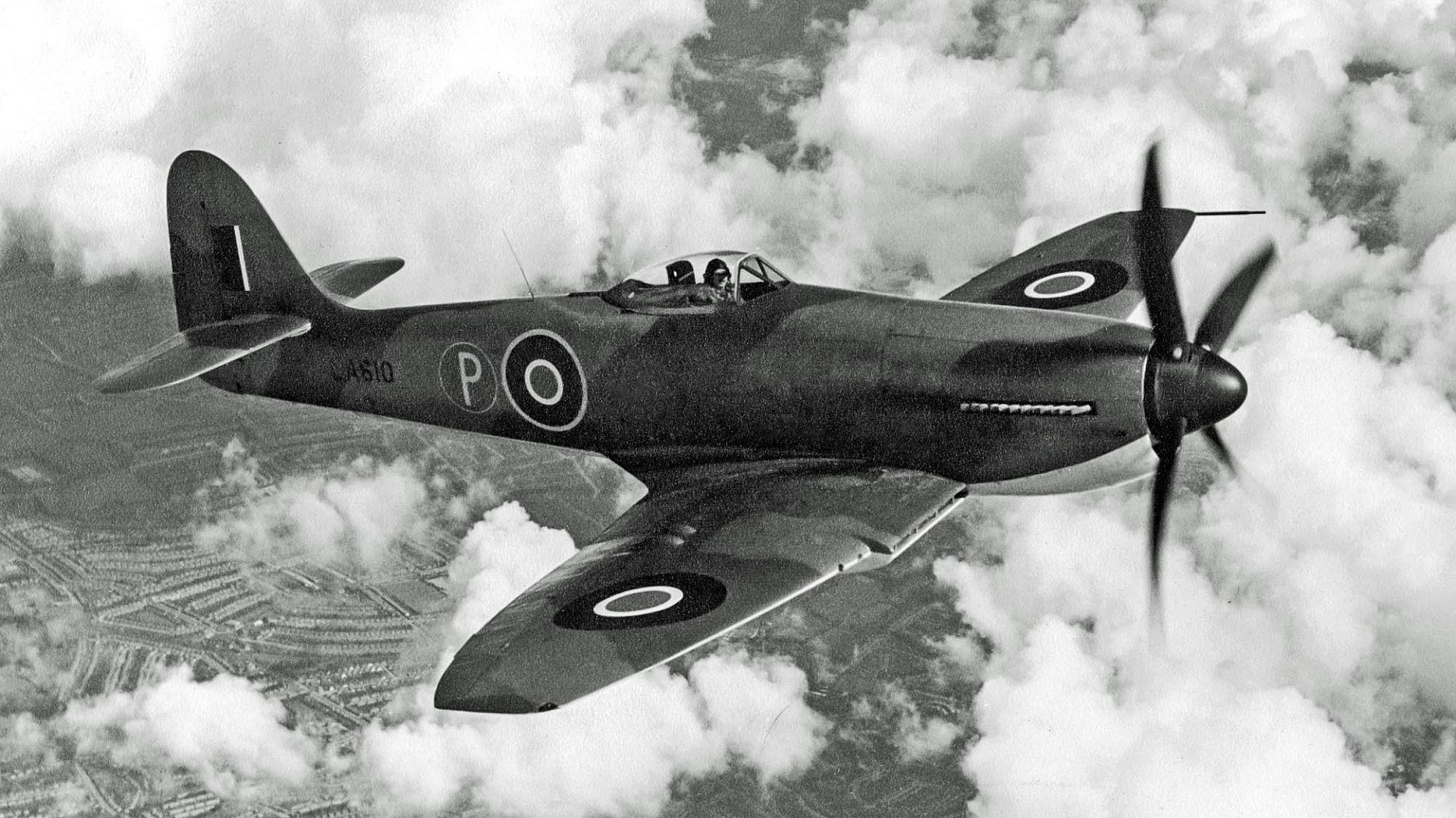




NX798 One of two Fury prototypes to specification F.2/43, the first to fly on 1 September 1944.
In April 1948, Hawker Test Pilot Bill Humble took the Hawker Fury prototype (NX798/G-AKRY) to Egypt during a Sales Tour. Things got a little strange when the Egyptians became so impressed with the aircraft that they commandeered it, refusing to return it. Once an amicable solution was established, the Egyptians subsequently placed an order for 12 non-navalised single-seaters, which were operated throughout the 1950s.

NX802 One of two Fury prototypes to specification F.2/43.
Sea Fury prototypes
SR661 A semi-navalised Fury prototype to Specification N.22/43, first flew on 21 February 1945 with a Centarus XII engine (later changed to a Centarus XVIII) and Rotol four-bladed propeller, did not have folding wings.
SR666 A fully navalised Fury prototype to Specification N.22/43, first flew on 12 October 1945 with a Centarus XV engine and a Rotol five-bladed propeller.


VB857 Sea Fury X prototype built by Boulton-Paul and first flew on 31 January 1946 with a Centarus XVI, later used as a FB11 prototype with a Centarus XVIII engine.
Sea Fury T.20 prototype
VX818 Prototype two-seat training variant to Specification N.19/47, originally ordered by Iraq it first flew on 15 January 1948.
Fury
RAF order for 200 aircraft placed on 28 April 1944; order cancelled.
Sea Fury F.10
Single-seat fighter version for the Royal Navy, 50 built by Hawker, an order for a further 300 placed at the same time to be built by Boulton Paul was cancelled. First production aircraft flew on 15 August 1946.

Sea Fury FB.11
Single-seat fighter-bomber for the Royal Navy, Royal Australian Navy, Royal Canadian Navy and Royal Netherlands Navy, 615 built, including 31 for the RAN and 53 for the RCN.



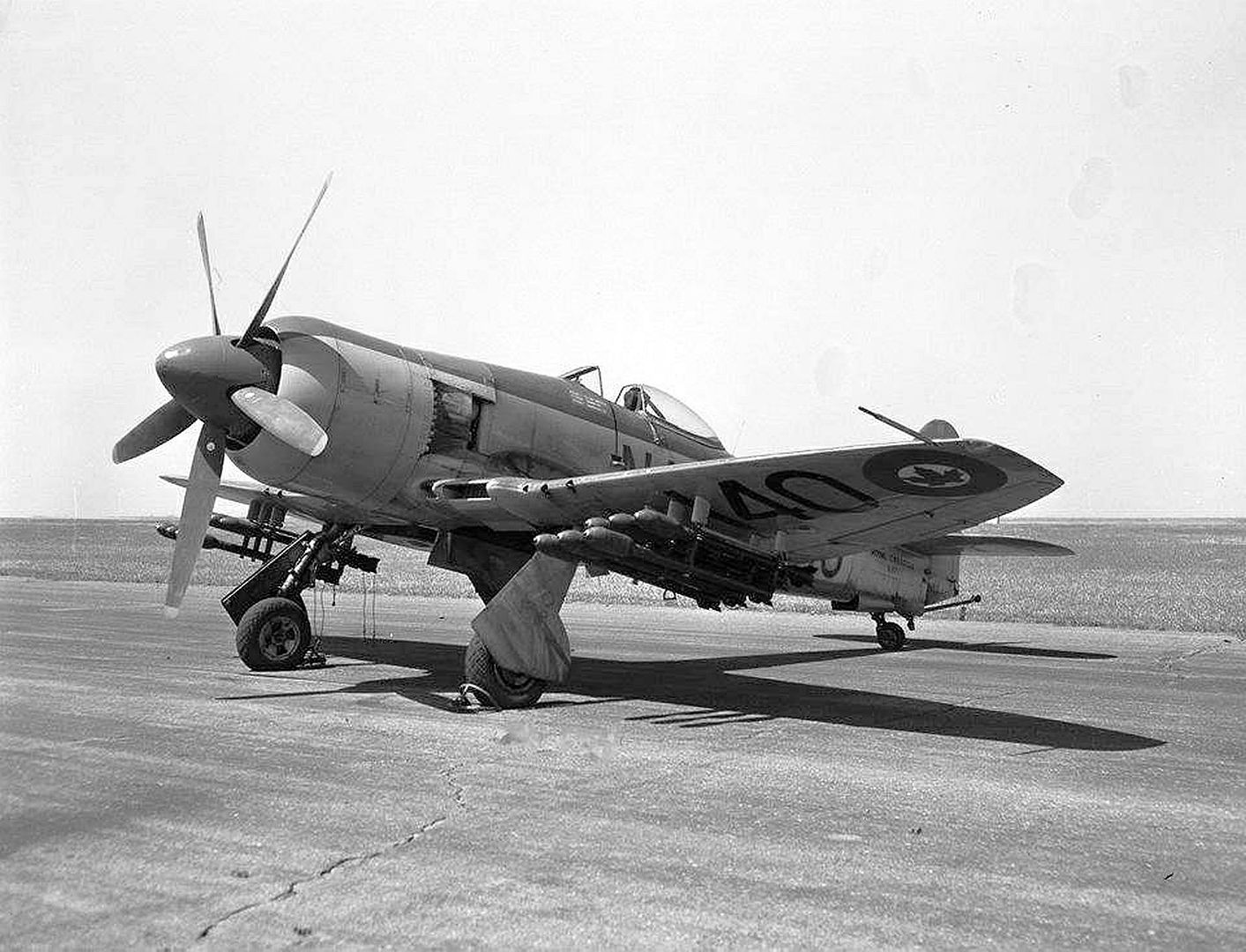
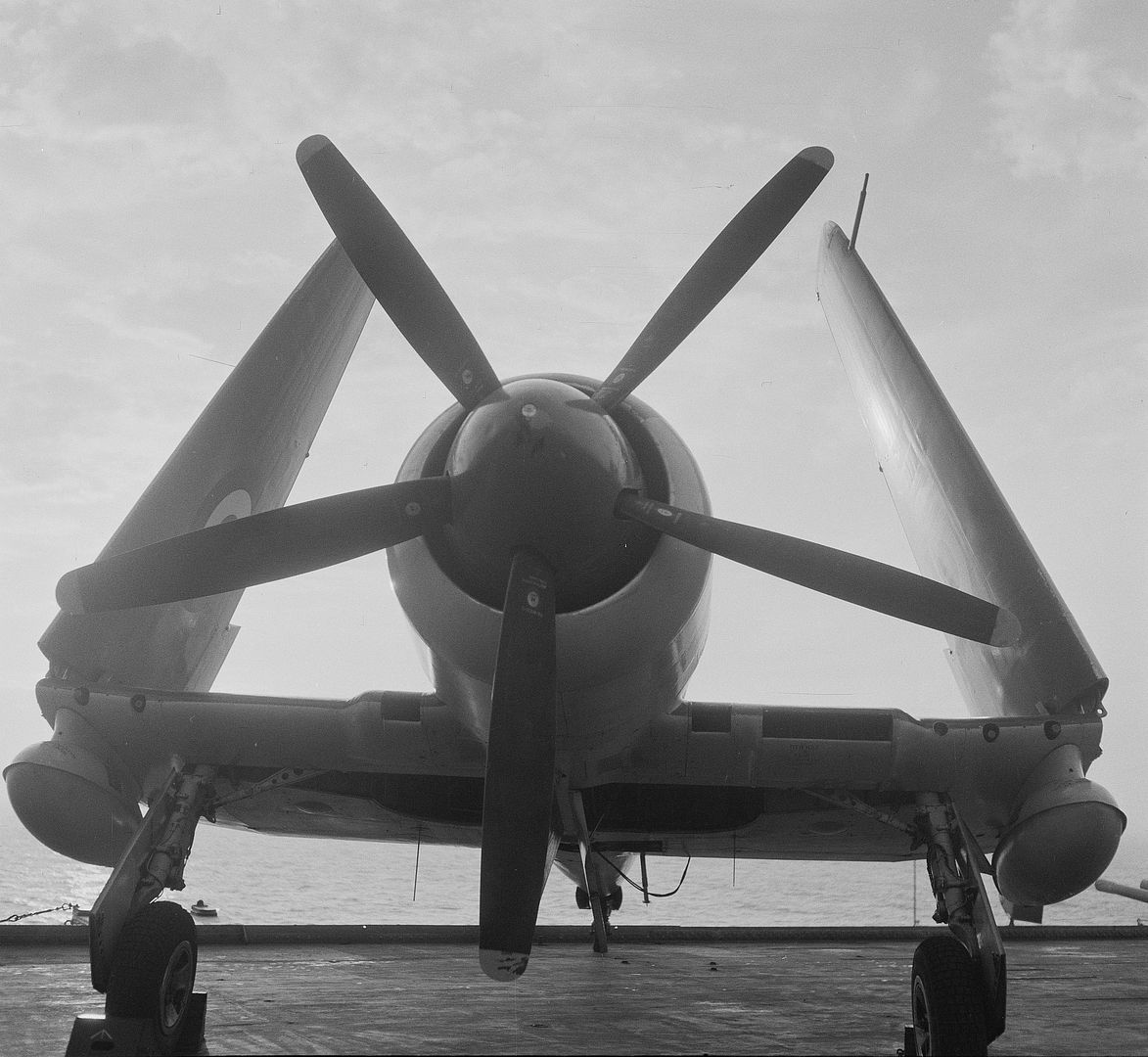

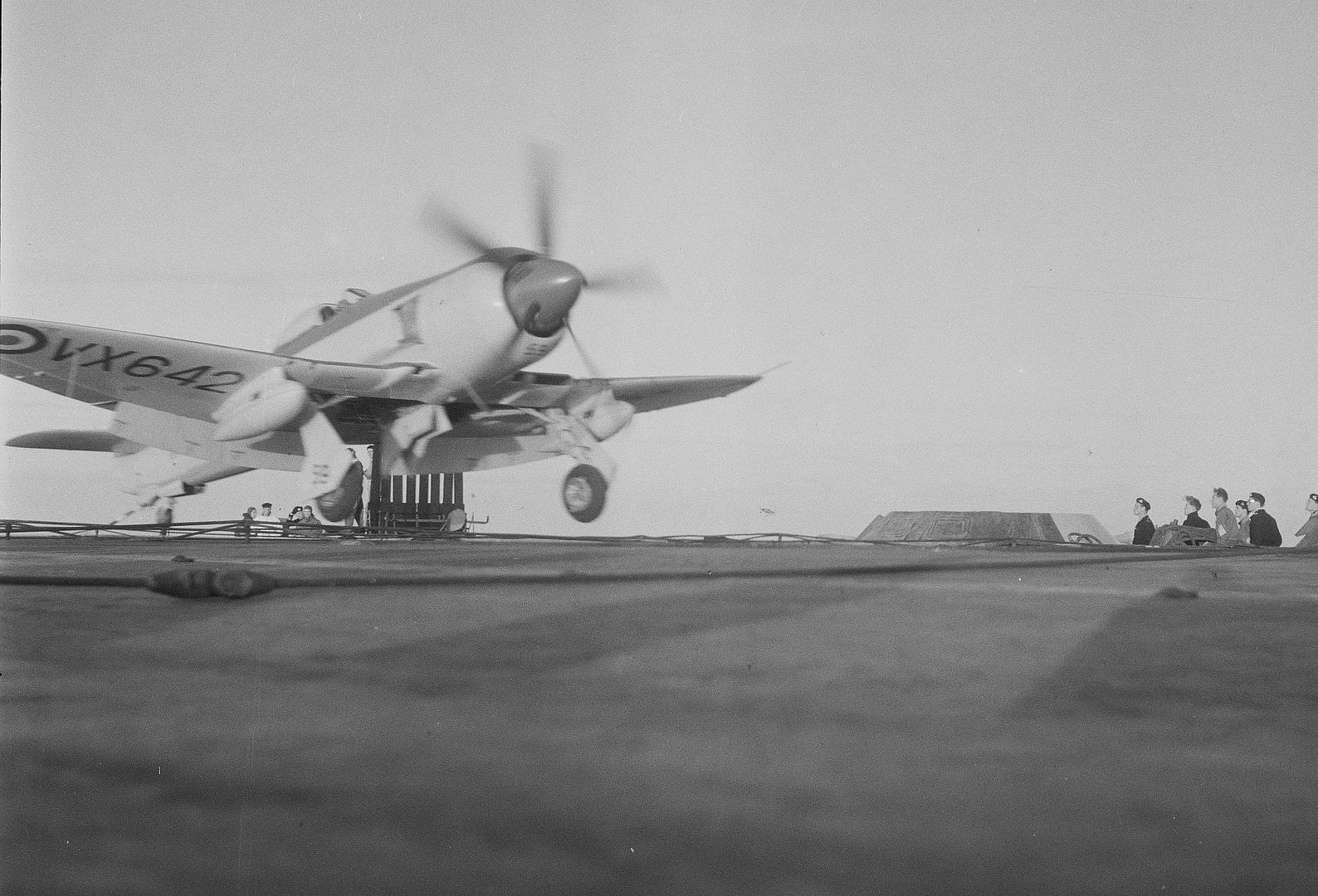



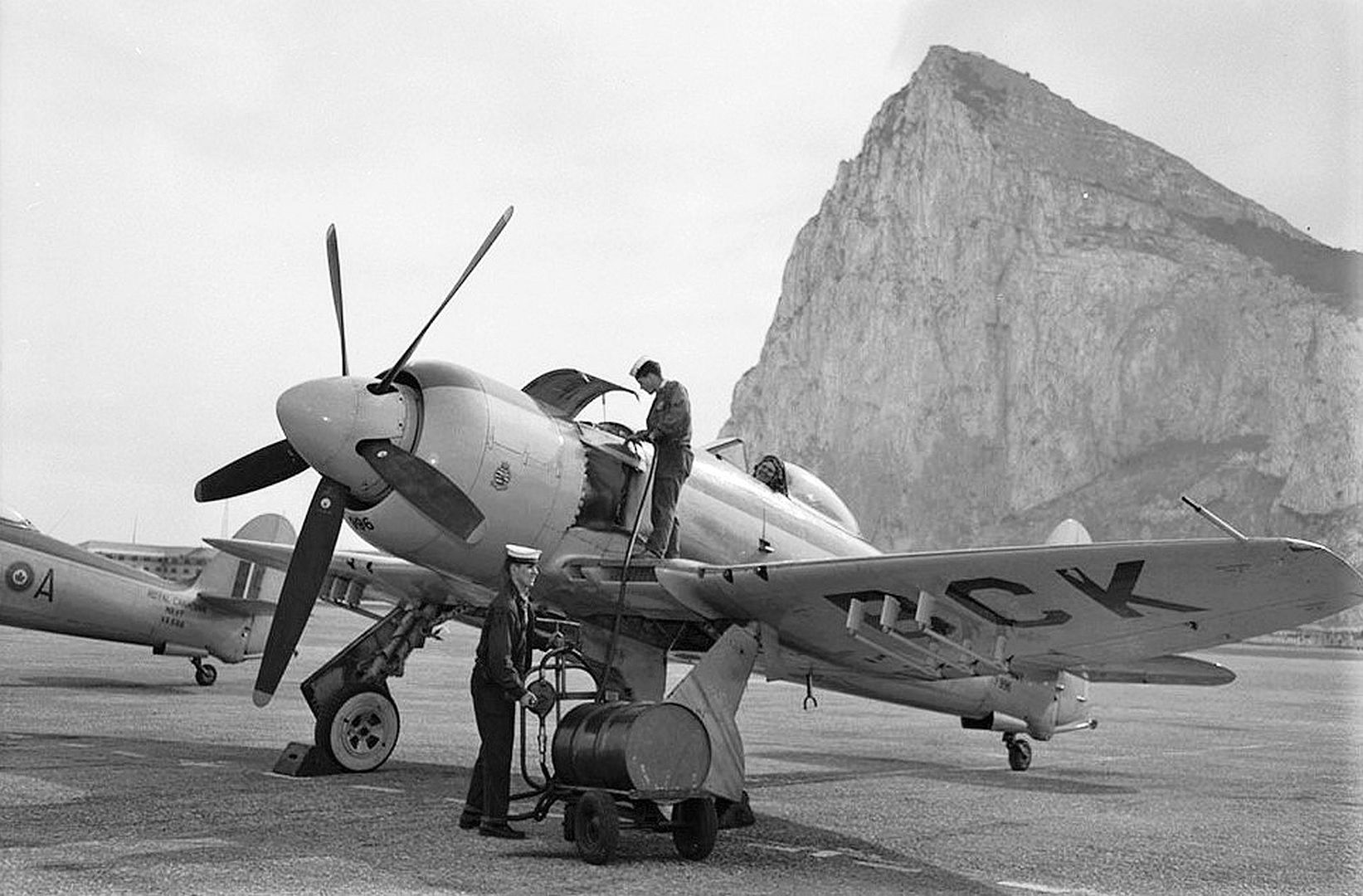





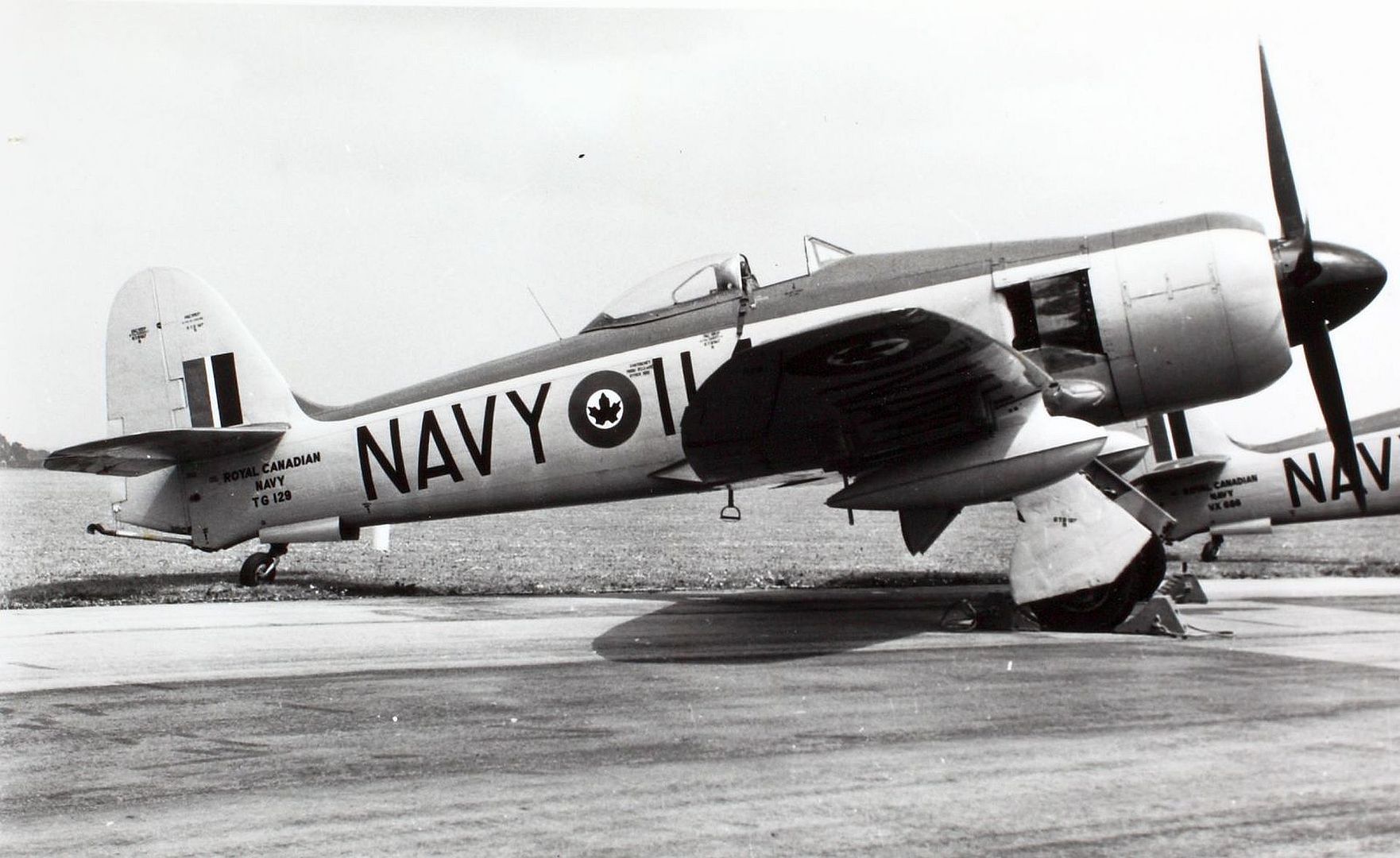









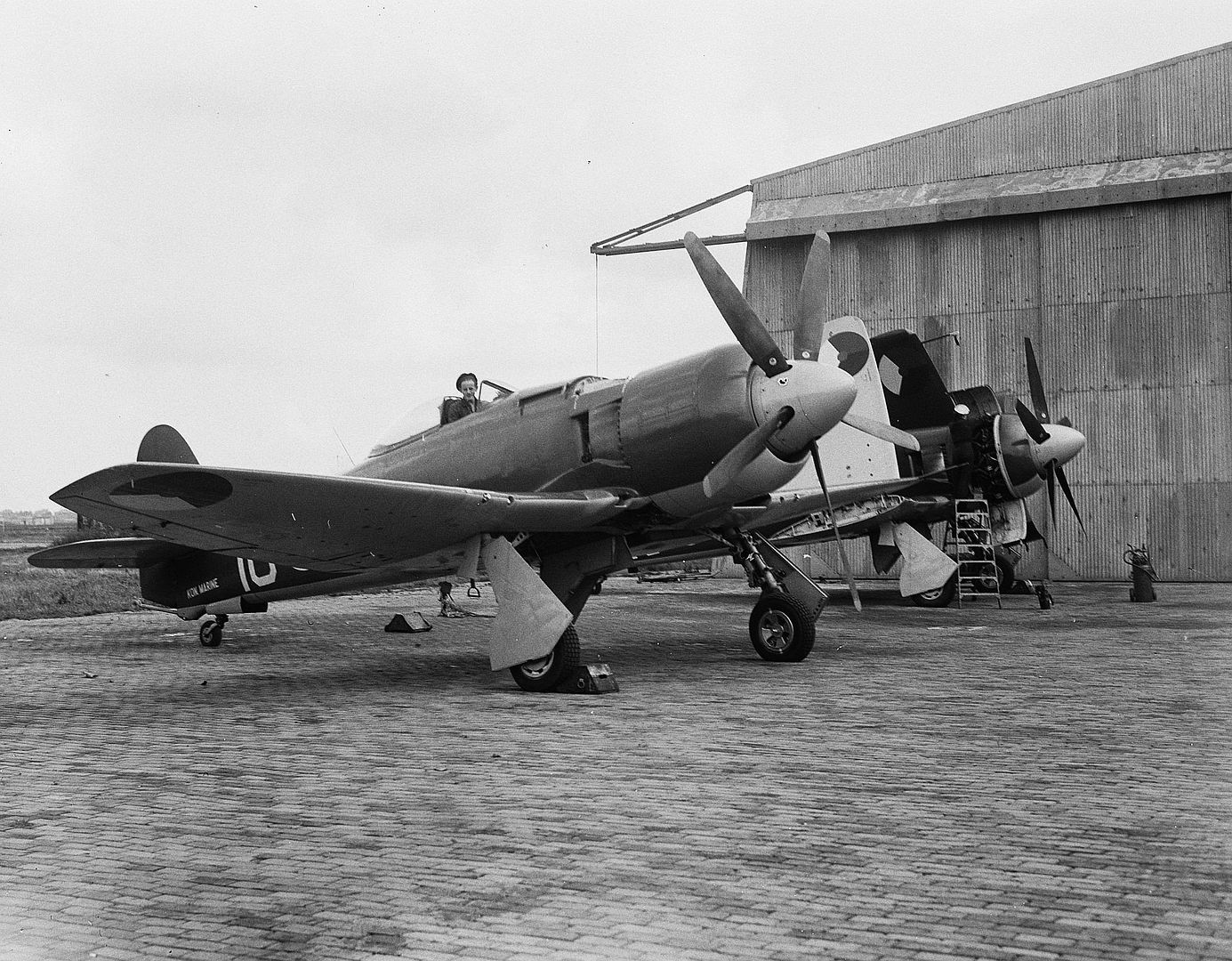












.jpg?width=1920&height=1080&fit=bounds)
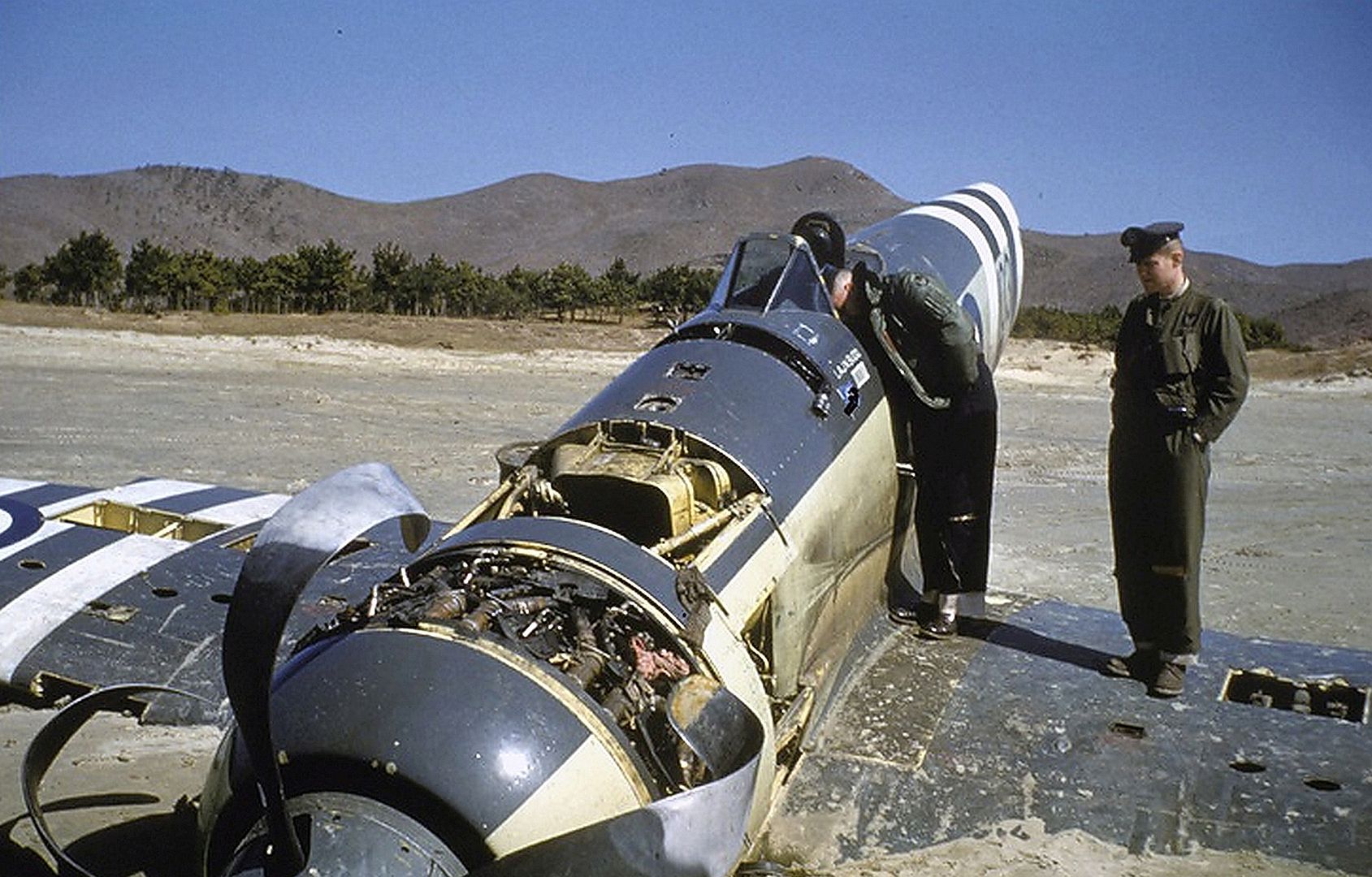


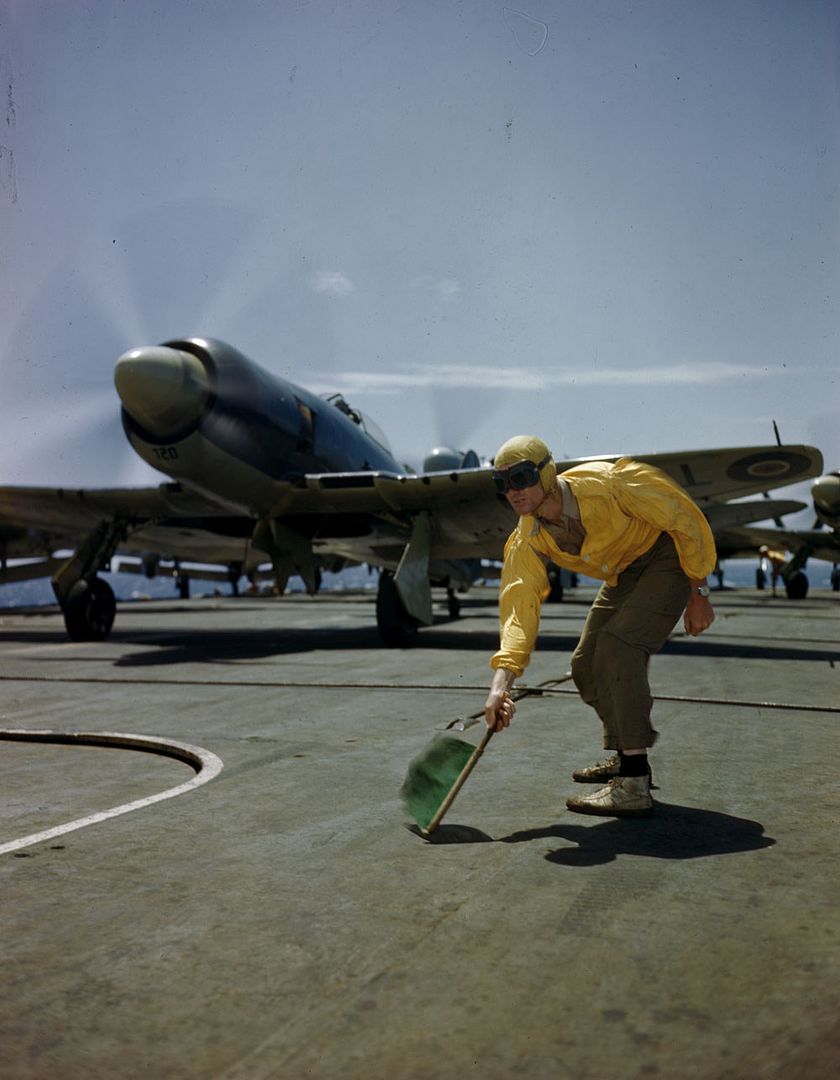

Sea Fury T.20
Two-seat training version for the Royal Navy, 61 built. Ten of these were later converted to target tugs (designated T.20S) for West Germany, operated by the civilian company Deutscher Luftfahrt-Beratungsdienst (DLB).




Sea Fury F.50
Single-seat fighter version for the Royal Netherlands Navy, 10 built._in_aanbouw_in_de_fabriek_van_Hawker_Aircraft_Ltd._te_Langham..jpg?width=1920&height=1080&fit=bounds)
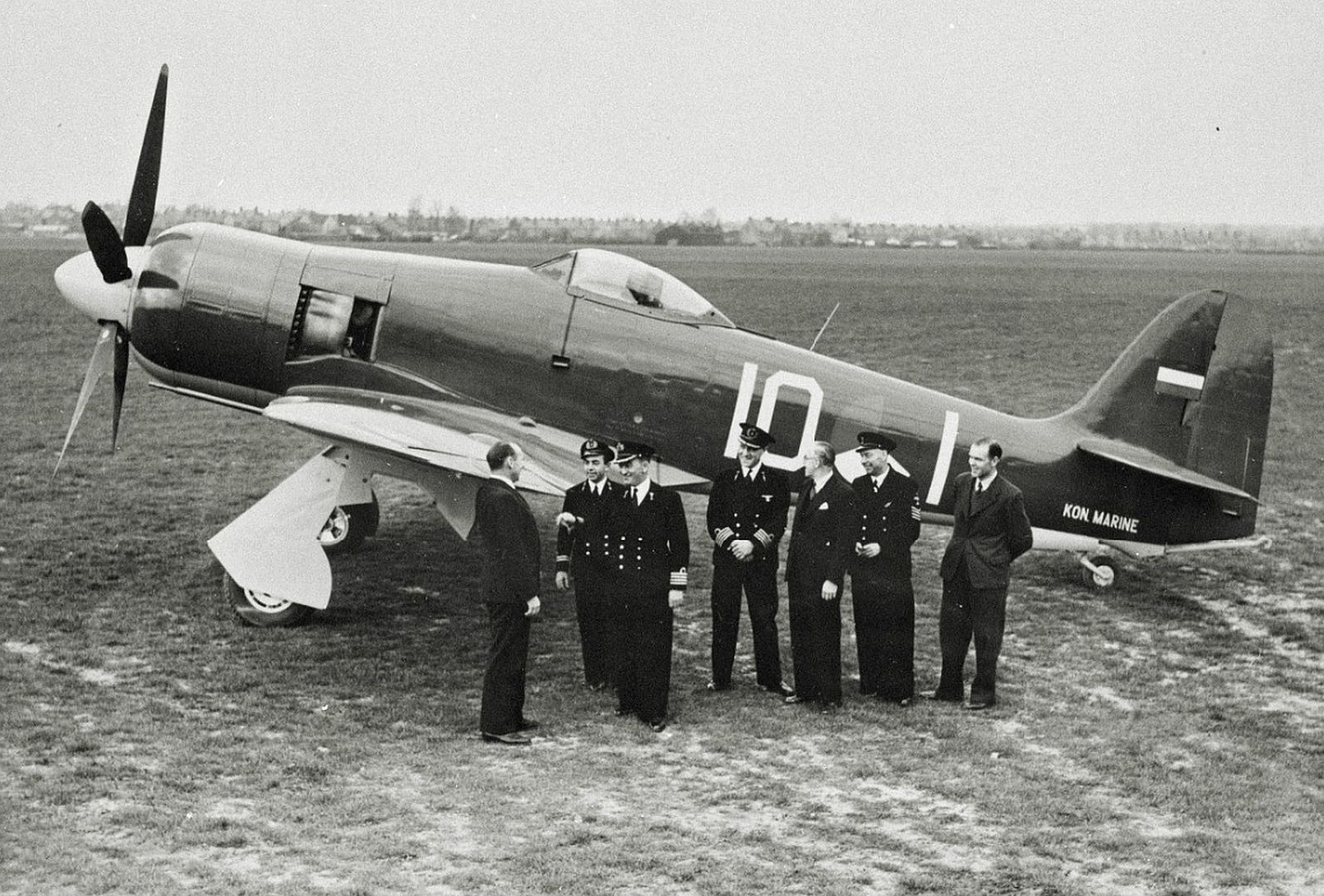

Sea Fury FB.51
Single-seat fighter-bomber version for the Royal Netherlands Navy, 25 built.
Fury FB.60
Single-seat fighter-bomber version for the Pakistan Air Force and the Royal Netherlands Navy, 93 built for Pakistan and 12 for the Netherlands.
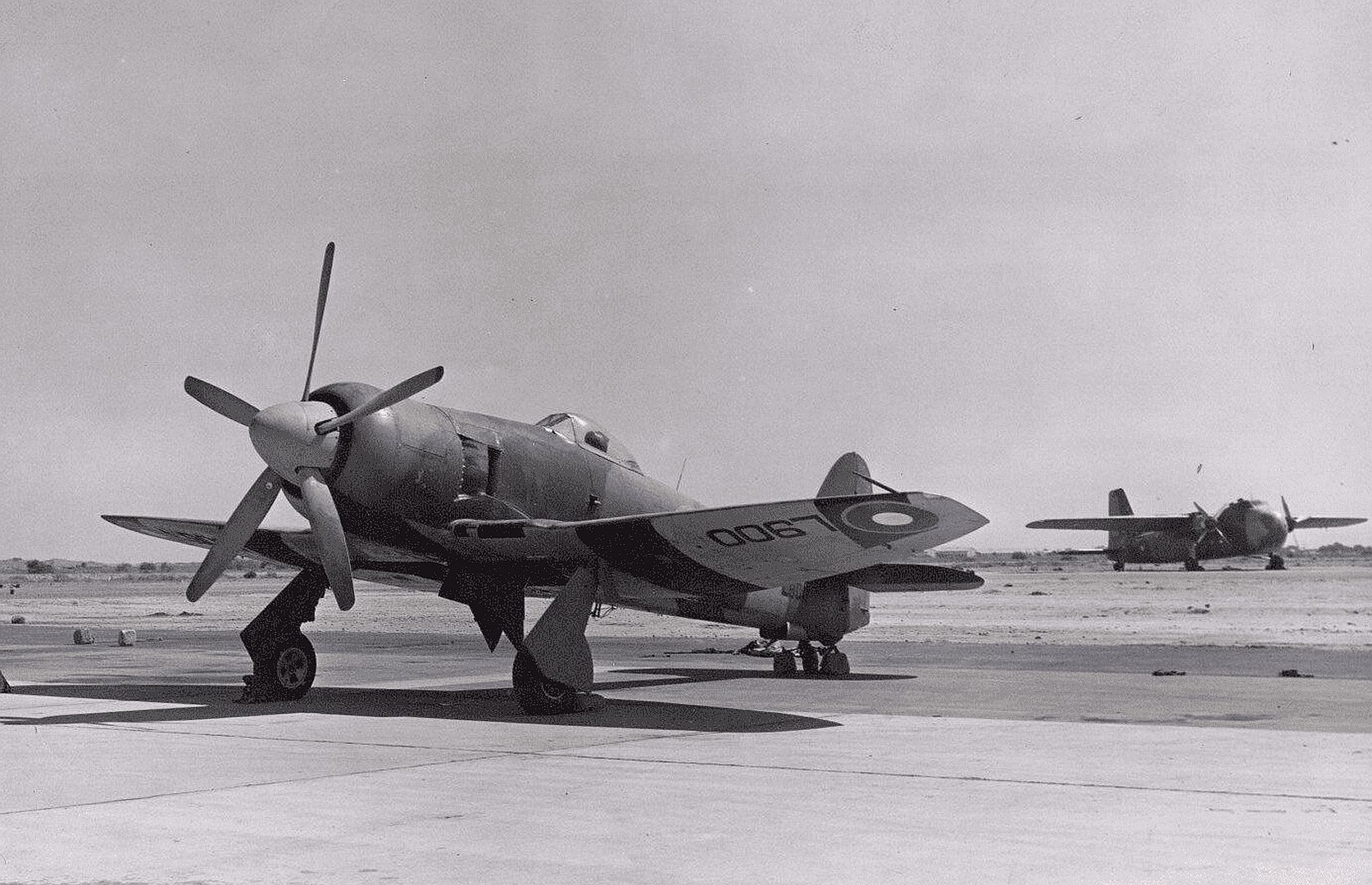
Fury T.61
Two-seat training version for the Pakistan Air Force, five built.
Fury I
Single-seat land-based fighter version for the Iraqi Air Force. Unofficially known as the "Baghdad Furies", 55 built.


Fury Trainer
Two-seat training version for the Iraqi Air Force, five built.

Specifications (FB.11)
General characteristics
Crew: One
Length: 34 ft 8 in (10.57 m)
Wingspan: 38 ft 4.75 in (11.7031 m)
Height: 15 ft 10.5 in (4.839 m)
Wing area: 280 sq ft (26 m2)
Empty weight: 9,240 lb (4,191 kg)
Gross weight: 12,350 lb (5,602 kg)
Max takeoff weight: 14,650 lb (6,645 kg)
Powerplant: 1 × Bristol Centaurus 18 18-cylinder air-cooled radial piston engine, 2,480 hp (1,850 kW) for take-off
Propellers: 5-bladed constant-speed propeller
Performance
Maximum speed: 460 mph (740 km/h, 400 kn) at 18,000 ft (5,500 m)
Range: 780 mi (1,260 km, 680 nmi)
Ferry range: 904 mi (1,455 km, 786 nmi) with two drop tanks
Service ceiling: 35,800 ft (10,900 m)
Rate of climb: 4,320 ft/min (21.9 m/s)
Armament
Guns: 4 × 20 mm (0.79 in) Hispano Mk V autocannon
Rockets: 12 × 3 in (76.2 mm) rockets
Bombs: 2,000 lb (910 kg) of bombs
Post a reply
- Go to Previous topic
- Go to Next topic
- Go to Welcome
- Go to Introduce Yourself
- Go to General Discussion
- Go to Screenshots, Images and Videos
- Go to Off topic
- Go to Works in Progress
- Go to Skinning Tips / Tutorials
- Go to Skin Requests
- Go to IJAAF Library
- Go to Luftwaffe Library
- Go to RAF Library
- Go to USAAF / USN Library
- Go to Misc Library
- Go to The Ops Room
- Go to Made in Germany
- Go to Campaigns and Missions
- Go to Works in Progress
- Go to Juri's Air-Raid Shelter
- Go to Campaigns and Missions
- Go to Works in Progress
- Go to Skinpacks
- Go to External Projects Discussion
- Go to Books & Resources
